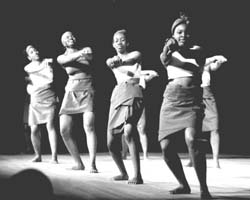

Colors of Rhythm Exhibits Artistic Diversity
by Andi Nelson and Alison Marshall
Thursday night, in Finney Chapel, performers from a variety of organizations came together to perform a celebration of cultural pride and artistic heritage in the Colors of Rhythm program. They celebrated unity, diversity and expression through a wide array of mediums. Downstage from a screen projecting drawings, murals and photographs, performers combined dance, music and vocals. The result was a symphony of cultures that illustrated the diverse talents that are often underrepresented at Oberlin.
The performance opened extravagantly with "The Sound of the Drums," a dance comprised of West African steps. To the sweet song of Angelique Kidgo, members of the African Student Association and ABUSUA step draped in cloth with African print.
The performance moved immediately to "Classical North Indian Kathak," a classical danced that originated in North India. The work was both lyrical and moving and, when compared with the first piece, highlighted the diverse pieces in the performance. Sophomore Soneli Seth combined precision with grace to keep her feet moving with the rhythm of the tabla music. Seth's focus and slight inclusion of the audience were incredible and one found oneself giggling and awestruck throughout the entire performance.
Following Kathak, the performance moved back into Africa, specifically Central Africa, to experience Zaiko, a style of dance popularized by the band Zaiko Langa Langa. The dance, which was characteristically fast-paced, was composed of the Soukos style of Zaiko and the ensemble presentation of the work was nothing short of exhilarating.
The audience continued their colorful journey to Mexico and next view "La Bruja," a Mexican folkloric dance from the region of Veracruz originating in the16th century. Junior Kate Martin, choreographer of this piece, designed an unbeatable performance that captured the zest of the period.

|
|
Celebrations of Movement: Student dancers perform works where cultural past meets present in the independent dance concert (photo by Brian Hodgkin) |
The adventure continued and included performances such as "Sarafina," which depicts the struggles of teachers and students during the apartheid era in South Africa, "Puchae Chum," a popular Korean folk dance and "Arrepentida," a salsa performance, and folk loric dances from Argentina.
Other notable performances included those by the Filipino American Students Association and Dance Diaspora. In addition, two traditional performances, the piece "Hip-Hop You the Love of My Life" celebrates Hip-Hop's roots in the Black aesthetic and shows the wide scope of the Colors of Rhythm students. Breakdance, rap, capoeira and
spoken word with a saxophone accompaniment combine to demonstrate the variety of influences that have contributed to modern methods of expression that have strong roots in ethnic forms.
Additionally, "Bhangra Fusion" was an upbeat and energetic fusion of reggae and bhangra, representing the presence of the South Asian diaspora and its resulting dance forms. Performers, cheered on by the audience, used candles in their light-hearted interactions with each other. Like "Bhangra Fusion," "Broken English" illustrated how vastly different cultures can combine to create new cultures in and of themselves.
The members of the piece represent the principles of the Third World Liberation Front 2000. The dance itself has traveled throughout various universities and communities internationally.
Like the audience, the shades in Colors of Rhythm traveled far and wide to harmonize for one night in Finney Chapel. Viewers lucky enough to catch Colors of Rhythm left invigorated and inspired and the broader message of the evening was clear: all people possess the essence of the colors of rhythm. All people embody these colors and owe it to themselves to celebrate it.
Copyright © 2000, The Oberlin Review.
Volume 128, Number 17, March 10, 2000
Contact us with your comments and suggestions.
|
News
|
Perspectives
|
|
|
Arts
|
Sports
|
Other
|